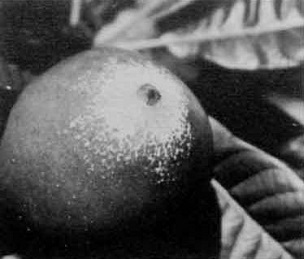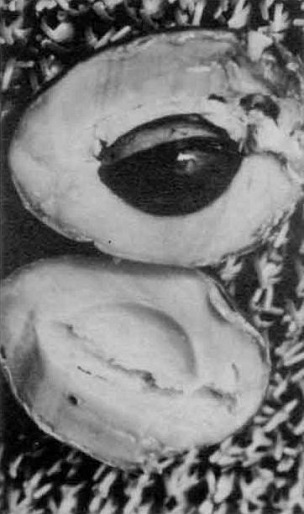From the Archives
of the Rare Fruit Council of Australia
by Wm. F. Whitman

The Green Sapote in South Florida
Scientific Name: Calocarpum viride
Family: Sapotaceae
 | While the green sapote fruit closely resembles
that of the mamey
sapote, the inside of it's
interior has a somewhat different appearance |
I
had read Wilson Popenoe's book Manual of Tropical and Subtropical
Fruits. Under the section of Sapotaceous fruits he stated, "The green
sapote Pouteria viride is really superior in flavour to the common sapote (P. sapote)".
We already had fruiting mamey sapote in Florida, but I had never heard
of the green sapote bearing in our subtropical state. A letter was
therefore sent to Dr. Popenoe at the Escuela Agricola Panamericana at
Tegucigalpa, Honduras where he was the director. In this
correspondence, I made a request for green sapote seeds. In his reply,
he stated there was only one of these trees on the campus and the
students picked all the fruit prior to reaching maturity. However he
did forward green sapote scionwood and suggested grafting it on
seedling rootstocks of the related mamey sapote.
In November of
1954 upon receiving the green sapote graftwood, I took it to the late
John Tower, propagator at the Brooks-Tower Nursery in Homestead,
Florida. I had recently imported six hundred mamey sapote seeds from
Havana, which I had given the above nursery, hoping to better establish
more of these Cuban fruit in South Florida. Mr Tower, an expert at
grafting, used Dr Popenoe's scionwood to graft up some of the resulting
mamey sapote seedlings as well as put scions of this Central American
fruit on mamey sapote trees which were approaching bearing size in the
nursery. After these scions took, I wrote Wilson Popenoe of our
success. He then sent me a reply in which he stated, "I suspect that
(this) is the first time anyone has made this graft".
What is
believed to be the first instance of the green sapote fruiting in
Florida took place seven years later in the fall of 1961. Prior to
this, hundreds of seeds of this sapotaceous fruit had been introduced
into our subtropical state by various agricultural experiment stations,
none of which survived to become bearing trees. My green sapote,
grafted on to the mamey sapote as a rootstock is currently (April 1993)
55 ft (17 m) high with a trunk diameter of 16 inches (41 cm) in spite
of taking every hurricane passing through this area since the late
fifties. Shortly ofter it was originally planted out in the ground, it
was attacked by fungus at the graft union causing extensive die-back
and nearly girdling the trunk. Bark from the infected area was removed
and a soft paste made up by mixing copper sulfate fungicide with Volck
agricultural oil was applied. This resulted in a complete recovery and
the fungus did not reappear.
My green sapote bears from late December through March.
The crop varies from hundreds of fruit to only a few dozen. As this
matures in the dead of winter I find Florida-grown green sapote lacking
flavour and seldom do I bother to harvest its ripe fruit. However, off
season, summer-ripening fruit are really delicious. Unfortunately these
out-of-season fruit seldom appear.
 | Green sapote produced by my tree have only
one seed. |
When
the green sapote was first introduced into Florida, it had been hoped
that they would prove to be cold resistant to a greater degree than the
common lowland mamey sapote. Observations by the writer suggest the
reverse to be true. During our infrequent, severe, winter cold fronts
the green sapote appears to be the more subject to cold damage of the
two. Also, as this Central American tree is reported to have a lower
limit of 3,000 ft elevation and an upper one of 7,000 ft elevation
where it is found growing in the wild, South Florida's near-sea level
altitude with its long, hot summers is quite different from its natural
environment. This results in seedling green sapote making poor growth.
However grafting them on the related mamey sapote improves their vigor.
It has been suggested that we should seek out green sapote that come
from the lowest elevations in their indigenous mountainous areas hoping
to discover strains more suited to the hot lowlands. Originally we had
done just the opposite, reasoning the trees coming from the highest
elevations would take the most cold.
When the first green sapote
trees bore in South Florida, many of us had high hopes for its future.
Since that time, the related mamey sapote has come into its own with
over 300 acres planted out in commercial groves. Meanwhile, the green
sapote remains a door-yard curiosity with no hope of a monetary future
here in Florida. Possibly if summer-bearing strains with superior fruit
quality were introduced, this seldom-seen Pouteria could become common
in our produce markets. Hopefully some member of the RFCA of Australia
can update us on their experiences with the green sapote. Unlike
Florida's flat lands, you have mountains, where this sapotaceous fruit
should thrive under conditions like its natural environment. Over the
years, I have made many green sapote seed shipments to various
Australians including Paul Recher, who on one occasion was mailed
thirty pounds. From what I have heard, you have found this fruit to
grow well and bear heavily on your "Continent Down Under".
Back to
Green Sapote Page
|
|
